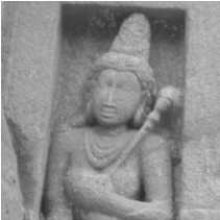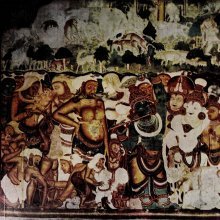Dharin, Dhārin, Dhari: 29 definitions
Introduction:
Dharin means something in Hinduism, Sanskrit, Jainism, Prakrit, Buddhism, Pali, Marathi, Hindi, biology. If you want to know the exact meaning, history, etymology or English translation of this term then check out the descriptions on this page. Add your comment or reference to a book if you want to contribute to this summary article.
Images (photo gallery)
In Hinduism
Ayurveda (science of life)
Source: gurumukhi.ru: Ayurveda glossary of termsDhāri (धारि):—The one that prevents the body from decay, a synonym of ayu

Āyurveda (आयुर्वेद, ayurveda) is a branch of Indian science dealing with medicine, herbalism, taxology, anatomy, surgery, alchemy and related topics. Traditional practice of Āyurveda in ancient India dates back to at least the first millenium BC. Literature is commonly written in Sanskrit using various poetic metres.
Shaktism (Shakta philosophy)
Source: Google Books: ManthanabhairavatantramDhārin (धारिन्) refers to “one who wears”, according to the Ṣaṭsāhasrasaṃhitā, an expansion of the Kubjikāmatatantra: the earliest popular and most authoritative Tantra of the Kubjikā cult.—Accordingly, “Or else, (he may be an ascetic who) always lives in a cave and eats roots, wears bark clothes [i.e., valkalāmbara-dhārin], keeps silence and is firm (in the observance of his ascetic’s) vow; whether he has dreadlocks or shaved head, he is ever intent on the practice of chastity. He knows the reality of concentration and meditation and does not keep the company of the worldly(-minded). [...]”.
Source: Brill: Śaivism and the Tantric Traditions (shaktism)Dhārin (धारिन्) (Cf. Dhāriṇī) refers to “one who carries (attributes in one’s hand)”, according to the King Vatsarāja’s Pūjāstuti called the Kāmasiddhistuti (also Vāmakeśvarīstuti), guiding one through the worship of the Goddess Nityā.—Accordingly, “[...] I take refuge with the goddesses of becoming minute and other great accomplishments for the sake of success. They hold wish-fulfilling jewels in both hands. They are moon-crested, three-eyed, and red in complexion. I revere Brahmāṇī and the other mother-goddesses. They carry a skull-bowl and red lily in their hands (dhāriṇī—kapālotpaladhāriṇī), their bodies are dark-colored like the leaves of bamboo, and they are clad in lovely [red] clothes resembling bandhūka flowers. [...]”.

Shakta (शाक्त, śākta) or Shaktism (śāktism) represents a tradition of Hinduism where the Goddess (Devi) is revered and worshipped. Shakta literature includes a range of scriptures, including various Agamas and Tantras, although its roots may be traced back to the Vedas.
Purana and Itihasa (epic history)
Source: archive.org: Shiva Purana - English TranslationDhārin (धारिन्) (Cf. Dhāriṇī) refers to “one who supports” (a particular system of philosophy), according to the Śivapurāṇa 2.3.13 (“Śiva-Pārvatī dialogue”).—Accordingly, as Śiva said to Pārvatī: “O Pārvatī, O upholder of the Sāṃkhya system [i.e., sāṅkhya-dhāriṇī], if you say so, O sweet-voiced lady, you render me unforbidden service every day. If I am the Brahman, the supreme lord, unsullied by illusion, comprehensible through spiritual knowledge and the master of illusion what will you do then?”.

The Purana (पुराण, purāṇas) refers to Sanskrit literature preserving ancient India’s vast cultural history, including historical legends, religious ceremonies, various arts and sciences. The eighteen mahapuranas total over 400,000 shlokas (metrical couplets) and date to at least several centuries BCE.
Shaivism (Shaiva philosophy)
Source: Brill: Śaivism and the Tantric TraditionsDhārin (धारिन्) refers to “one wearing (a dress)”, according to the Guhyasūtra chapter 9.—Accordingly, “[...] [The Lord spoke]:—Wearing half the dress of a woman (ardhastrī-veśa-dhārin) and half [that of] a man, on one half, he should place [feminine] tresses, on one half, he should wear matted locks. On one half, there should be a forehead mark; on one half a [forehead] eye. A ring [should be] in one ear; a [pendant] ear-ornament in one ear. [...]”.
Source: SOAS University of London: Protective Rites in the Netra TantraDhārin (धारिन्) refers to “one holding (an attribute)” (e.g., ‘one holding a sword’), according to the Netratantra of Kṣemarāja: a Śaiva text from the 9th century in which Śiva (Bhairava) teaches Pārvatī topics such as metaphysics, cosmology, and soteriology.—Accordingly, [verse 10.1-7ab, while describing the appearance and worship of Bhairava]—“[...] He] bears a sword and shield (dhārin—khaḍgakheṭakadhāriṇaṃ), holds a hook and noose. [His] hand[s and posed] in the wish fulfilling and protection [mudrās. He] holds the thunderbolt of a great hero. [He also] holds an axe and a hatchet. Having worshipped Bhairava, [the Mantrin] remembers being joined in union [with] him, [in the same way as] dissolution in fire”.

Shaiva (शैव, śaiva) or Shaivism (śaivism) represents a tradition of Hinduism worshiping Shiva as the supreme being. Closely related to Shaktism, Shaiva literature includes a range of scriptures, including Tantras, while the root of this tradition may be traced back to the ancient Vedas.
In Jainism
General definition (in Jainism)
Source: The University of Sydney: A study of the Twelve ReflectionsDhārin (धारिन्) or Dehadhārin refers to “those possessing (a body)”, according to the 11th century Jñānārṇava, a treatise on Jain Yoga in roughly 2200 Sanskrit verses composed by Śubhacandra.—Accordingly, “Also all connections are obtained by all those possessing a body (deha-dhārin) who have roamed about for time without a beginning in the wombs of mobile and immobile beings”.

Jainism is an Indian religion of Dharma whose doctrine revolves around harmlessness (ahimsa) towards every living being. The two major branches (Digambara and Svetambara) of Jainism stimulate self-control (or, shramana, ‘self-reliance’) and spiritual development through a path of peace for the soul to progess to the ultimate goal.
Biology (plants and animals)
Source: Wisdom Library: Local Names of Plants and DrugsDhari [ଧାରୀ] in the Odia language is the name of a plant identified with Salvadora persica L. from the Salvadoraceae (Salvadora) family. For the possible medicinal usage of dhari, you can check this page for potential sources and references, although be aware that any some or none of the side-effects may not be mentioned here, wether they be harmful or beneficial to health.
Source: Wisdom Library: Local Names of Plants and DrugsDharin [धारिन्] in the Sanskrit language is the name of a plant identified with Salvadora persica L. from the Salvadoraceae (Salvadora) family. For the possible medicinal usage of dharin, you can check this page for potential sources and references, although be aware that any some or none of the side-effects may not be mentioned here, wether they be harmful or beneficial to health.

This sections includes definitions from the five kingdoms of living things: Animals, Plants, Fungi, Protists and Monera. It will include both the official binomial nomenclature (scientific names usually in Latin) as well as regional spellings and variants.
Languages of India and abroad
Pali-English dictionary
Source: BuddhaSasana: Concise Pali-English Dictionarydhari : (aor. of dharati) lasted; continued; lived.
Source: Sutta: The Pali Text Society's Pali-English DictionaryDhārin, (adj.—°) (Sk. dhārin, see dhāreti & cp. °dhara, °dhāra) holding, wearing, keeping; often in phrase antimadeha° “wearing the last body” (of an Arahant) S.I, 14; Sn.471; It.32, 40.—J.I, 47 (virūpa-vesa°); Dāvs.V, 15.—f. °inī Pv.I, 108 (kāsikuttama°). (Page 341)

Pali is the language of the Tipiṭaka, which is the sacred canon of Theravāda Buddhism and contains much of the Buddha’s speech. Closeley related to Sanskrit, both languages are used interchangeably between religions.
Marathi-English dictionary
Source: DDSA: The Molesworth Marathi and English DictionaryDhārī (धारी).—f ( H) A narrow border or a colored strip along a cloth.
--- OR ---
dhārī (धारी).—a S That assumes or takes. In comp. as rūpadhārī, yajñōpavītadhārī, avatāradhārī, daṇḍadhārī.
Source: DDSA: The Aryabhusan school dictionary, Marathi-EnglishDhārī (धारी).—f A narrow border of a coloured strip along a cloth.
Marathi is an Indo-European language having over 70 million native speakers people in (predominantly) Maharashtra India. Marathi, like many other Indo-Aryan languages, evolved from early forms of Prakrit, which itself is a subset of Sanskrit, one of the most ancient languages of the world.
Sanskrit dictionary
Source: DDSA: The practical Sanskrit-English dictionaryDhārin (धारिन्).—a. (-ṇī f.) [धृ-णिनि (dhṛ-ṇini)]
1) Carrying, bearing, sustaining, preserving, having, holding, supporting; पादाम्भोरुहधारि (pādāmbhoruhadhāri) Gītagovinda 12; कर° (kara°) &c.
2) Keeping in one's memory, possessed of retentive memory; अज्ञेभ्यो ग्रन्थिनः श्रेष्ठा ग्रन्थिभ्यो धारिणो वराः (ajñebhyo granthinaḥ śreṣṭhā granthibhyo dhāriṇo varāḥ) Manusmṛti 12.13.
3) Edged, observing, doing; यज्ञधारी च सततम् (yajñadhārī ca satatam) Mahābhārata (Bombay) 12.34.1.
Source: Cologne Digital Sanskrit Dictionaries: Shabda-Sagara Sanskrit-English DictionaryDhārin (धारिन्).—mfn. (-rī-riṇī-ri) 1. Having, holding, keeping, possessing. 2. Edged. m. (-rī) A sort of tree: see pīlu. E. dhārā an edge, &c. ṇini aff. or dhāraṃ ṛṇaṃ śīdhyatvena asti asya . strīyāṃ ṅīp .
Source: Cologne Digital Sanskrit Dictionaries: Benfey Sanskrit-English DictionaryDhārin (धारिन्).—i. e. dhṛ + in, adj., f. iṇī. 1. Bearing, Mahābhārata 13, 4350. 2. Having, [Raghuvaṃśa, (ed. Stenzler.)] 12, 41. 3. Knowing, Kāthas. 13, 20. 4. Maintaining, Mahābhārata 1, 2596. 5. Keeping. nyāsa-, A depositary, [Mānavadharmaśāstra] 8, 196. 6. Retaining (what one has read), [Mānavadharmaśāstra] 12, 103. 7. Observing, [Rāmāyaṇa] 3, 1, 35.
Source: Cologne Digital Sanskrit Dictionaries: Cappeller Sanskrit-English DictionaryDhāri (धारि).—[adjective] holding, bearing (—°).
Source: Cologne Digital Sanskrit Dictionaries: Cappeller Sanskrit-English DictionaryDhārin (धारिन्).—1. [adjective] holding, bearing, wearing, possessing, keeping (also in one’s memory), retaining, supporting, observing. [feminine] ṇī the earth, a woman’s name.
--- OR ---
Dhārin (धारिन्).—2. [adjective] streaming.
Source: Cologne Digital Sanskrit Dictionaries: Monier-Williams Sanskrit-English DictionaryDhāri (धारि):—[from dhāra] mfn. holding, bearing [Scholiast or Commentator]
Source: Cologne Digital Sanskrit Dictionaries: Monier-Williams Sanskrit-English Dictionary1) Dhārin (धारिन्):—[from dhāra] 1. dhārin mfn. bearing, wearing, holding, possessing, keeping in one’s memory, maintaining, observing (with [genitive case] or ifc.), [Manu-smṛti; Mahābhārata; Kāvya literature] etc.
2) [v.s. ...] = poṣka (?), [Harivaṃśa 11986] ([Nīlakaṇṭha])
3) [v.s. ...] m. Careya Arborea or Salvadora Persica, [cf. Lexicographers, esp. such as amarasiṃha, halāyudha, hemacandra, etc.]
Source: Cologne Digital Sanskrit Dictionaries: Yates Sanskrit-English DictionaryDhārin (धारिन्):—(rī) 5. m. A sort of tree.
Source: DDSA: Paia-sadda-mahannavo; a comprehensive Prakrit Hindi dictionary (S)Dhārin (धारिन्) in the Sanskrit language is related to the Prakrit word: Dhāri.
[Sanskrit to German]
Sanskrit, also spelled संस्कृतम् (saṃskṛtam), is an ancient language of India commonly seen as the grandmother of the Indo-European language family (even English!). Closely allied with Prakrit and Pali, Sanskrit is more exhaustive in both grammar and terms and has the most extensive collection of literature in the world, greatly surpassing its sister-languages Greek and Latin.
Hindi dictionary
Source: DDSA: A practical Hindi-English dictionaryDhārī (धारी):—(nf) a stripe; line; an adjectival suffix meaning one who or that which holds/supports/possesses/maintains/wears; ~[dāra] striped, striate.
...
Prakrit-English dictionary
Source: DDSA: Paia-sadda-mahannavo; a comprehensive Prakrit Hindi dictionaryDhāri (धारि) in the Prakrit language is related to the Sanskrit word: Dhārin.
Prakrit is an ancient language closely associated with both Pali and Sanskrit. Jain literature is often composed in this language or sub-dialects, such as the Agamas and their commentaries which are written in Ardhamagadhi and Maharashtri Prakrit. The earliest extant texts can be dated to as early as the 4th century BCE although core portions might be older.
Nepali dictionary
Source: unoes: Nepali-English Dictionary1) Dhari (धरि):—pp. even; including; also;
2) Dhārī (धारी):—adj. 1. bearing; holding; wearing; 2. having good memory power; 3. taking debt from others;
Nepali is the primary language of the Nepalese people counting almost 20 million native speakers. The country of Nepal is situated in the Himalaya mountain range to the north of India.
See also (Relevant definitions)
Starts with: Dharimta, Dharini, Dharinidhava, Dharinidhavate, Dharitva, Tar-invalnan, Tarincakam, Tarini.
Ends with (+119): Acamanadharin, Achamanadharin, Adharin, Agninityadharin, Angadharin, Anjalimaladharin, Ankushadharin, Antimadharin, Anuddharin, Anudharin, Anuveladharin, Ardhacandradharin, Asangabaladharin, Asidharin, Astradharin, Avadharin, Ayudhadhari, Bhasmadhari, Bhushanadharin, Buddhavapurdharin.
Full-text (+188): Kanthadharin, Kiritadharin, Veshadharin, Dhanurdharin, Nistrimshadharin, Kshitidharin, Vishvadharin, Sarvadhari, Ushnishadharin, Cakkaratari, Astradharin, Ulkadharin, Pretasthi, Kundaladharin, Rupadharitva, Shiladharin, Jatadharishaivamata, Lingadharin, Malabharin, Sarvadharin.
Relevant text
Search found 25 books and stories containing Dharin, Dhārin, Dhari, Dhārī, Dhāri; (plurals include: Dharins, Dhārins, Dharis, Dhārīs, Dhāris). You can also click to the full overview containing English textual excerpts. Below are direct links for the most relevant articles:
Prasthanatrayi Swaminarayan Bhashyam (Study) (by Sadhu Gyanananddas)
5. Guruparampara in Svāminārāyaṇa Faith: A Live Philosophy < [Chapter 1 - Introduction]
Vakyapadiya of Bhartrihari (by K. A. Subramania Iyer)
Verse 3.14.70 < [Book 3 - Pada-kāṇḍa (14): Vṛtti-samuddeśa (On Ccomplex Formation)]
Garga Samhita (English) (by Danavir Goswami)
Verse 1.3.22 < [Chapter 3 - Description of the Lord’s Appearance]
Verse 2.22.4 < [Chapter 22 - The Rāsa-dance Pastime]
Verse 8.13.112 < [Chapter 13 - A Thousand Names of Lord Balarāma]
Chaitanya Bhagavata (by Bhumipati Dāsa)
Verse 3.5.195 < [Chapter 5 - The Pastimes of Nityānanda]
Verse 3.8.148 < [Chapter 8 - Mahāprabhu’s Water Sports in Narendra- sarovara]
Verse 3.9.242 < [Chapter 9 - The Glories of Advaita]
Brihad Bhagavatamrita (commentary) (by Śrī Śrīmad Bhaktivedānta Nārāyana Gosvāmī Mahārāja)
Verse 2.1.74 < [Chapter 1 - Vairāgya (renunciation)]
Verse 1.7.108 < [Chapter 7 - Pūrṇa (pinnacle of excellent devotees)]
Verse 2.1.206 < [Chapter 1 - Vairāgya (renunciation)]
Pallava period (Social and Cultural History) (by S. Krishnamurthy)
Upanayana ceremony and Sandhya-vandanam ritual < [Chapter 3 - Socio-Religious Life]
The cultural life of the Pallava Period < [Chapter 4 - Material Culture of the People]
Dancing girls in temples < [Chapter 3 - Socio-Religious Life]



